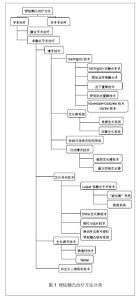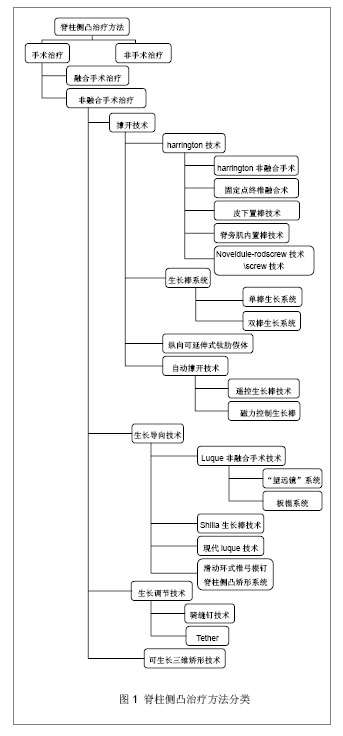Chinese Journal of Tissue Engineering Research ›› 2013, Vol. 17 ›› Issue (17): 3174-3183.doi: 10.3969/j.issn.2095-4344.2013.17.018
Previous Articles Next Articles
Development and current situation of non-fusion surgery for the treatment of scoliosis in children
He Yao1, Li Kai2, Zhao Sheng2, Li Peng-cui3, Wei Xiao-chun2
- 1 Second Clinical Medical College of Shanxi Medical University, Taiyuan 030001, Shanxi Province, China
2 Department of Orthopedics, Second Affiliated Hospital of Shanxi Medical University, Taiyuan 030001, Shanxi Province, China
3 Shanxi Key Laboratory of Bone and Soft Tissue Healing, Second Affiliated Hospital of Shanxi Medical University, Taiyuan 030001, Shanxi Province, China
-
Received:2012-11-13Revised:2012-12-13Online:2013-04-23Published:2013-04-23 -
Contact:Wei Xiao-chun, Professor, Doctoral supervisor, Department of Orthopedics, Second Affiliated Hospital of Shanxi Medical University, Taiyuan 030001, Shanxi Province, China weixiaochun06@yahoo.com.cn
CLC Number:
Cite this article
He Yao, Li Kai, Zhao Sheng, Li Peng-cui, Wei Xiao-chun. Development and current situation of non-fusion surgery for the treatment of scoliosis in children[J]. Chinese Journal of Tissue Engineering Research, 2013, 17(17): 3174-3183.
share this article
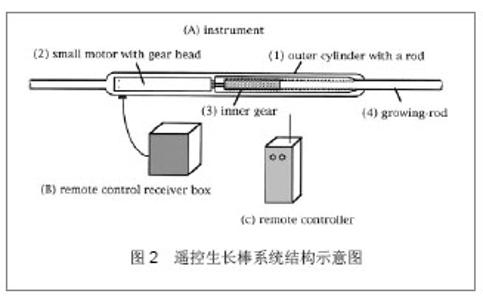
2.1 撑开技术 Harrington技术: Harrington[3]最早于1962年设计了著名的Harringtong棒,矫形棒通过椎板钩与侧凸上下稳定椎体相固定,运用矫形器对侧凸脊柱凹侧撑开,凸侧加压,然后Harrington棒固定,维持脊柱的矫形,使凸凹侧生长重获平衡。1978年Marchetti和Faldini对Harrington技术进行改进,先对上下置钩点临近上下椎体进行融合手术,五六个月后再行Harrington技术矫形,随后进行系列撑开延长手术。对置钩点上下椎体进行融合增加了置钩点的稳定性,减少了椎板骨折和脱钩的风险。由于仍然延续了Harrington技术的骨膜下剥离技术,脊柱自发融合率较高,1984年Moe等[4]针对这一弊端进行改进,发明皮下置棒术。皮下置棒术不仅对上下固定椎体进行骨膜下剥离,减少剥离引起的侧凸全节段的自发融合,另外,棒子中部加粗,表面光滑,在矢状面按照脊柱生理弯曲预弯,术后进行Milwaukee支具固定,如果cobb角增大10°行撑开延长手术。另一种针对骨膜下剥离的改进是Blakemore等[5]提出的棘旁肌内置棒术,生长棒置于棘旁肌内既可以减少骨膜的剥离,又可使棒更靠近脊柱,利于发挥矫形作用。他报道29例Isola单棒技术或者联合有限顶椎融合手术治疗的一组病例,单根Isola矫形棒置于棘旁肌内,不行骨膜下剥离,以减小自发融合。他们认为保守治疗失败的早发性脊柱侧凸,该方法是一种有效的措施。 Novel dule-rod screw技术:双棒钉技术是2009年Zhang等[6]对Harrington系统的改进,针对单棒顶点和头端张力较高导致假关节的形成和断棒的发生率较高,设计一种新的双棒钉,在单棒的顶点或者头端张力较高的节段增加第二根段棒,以增加该节段的硬度和稳定性。通过增加结构的稳定性预防假关节的形成,增加矫形的力量,减少钉子的脱出。他对12个猪的胸椎进行生物力学的测定,单棒系统屈曲时中部的张力比头端和尾端大39%-51%,当扭转和侧方弯曲时头部的张力比中部和尾部大39%-65%。当在顶端和中部添加第二根棒后,在屈曲和侧方弯曲时中间部的张力减少50%-72%。对于单棒系统,双棒系统明显的增加系统的稳定性,但是对比添加第二棒的单棒系统,双棒系统没有增加顶端与中间交界部分的稳定性。因此,对标准的单棒系统在顶端与中间部交界处增加第二根棒,增加系统的硬度及稳定性,这种结构通过优化系统的硬度或许可以预防假关节的形成和断棒。但双棒钉本身为非对称结构,使其植入的位置受到限制。 生长棒系统:①单棒系统:将Harringtong棒改为两根较短的单棒,通过连接器置于系统的中部,手术时上下固定点锁死,两棒的可动端置于连接器内锁定,延长手术时只切开连接器位置的皮肤,通过连接器进行撑开操作,该技术可将矫形棒为脊柱生长预留的棒长集中在连接器处,减少两端预留棒长造成的皮下突起,而且撑开力量平均分散到两端,减少两端连接点的骨折,脱钩风险。当cobb角增加15°即进行撑开手术,或者每6个月撑开1次,撑开的越频繁,脊柱的生长获得的越多,矫形效果也越明显[7],但反复手术会促进脊柱后路自发融合及肋椎关节的自发融合,增加脊柱侧凸的僵硬度。并发症的发生也很高,主要是断棒、脱钩、连接器松动、感染。Elsebai等[8]回顾性研究19例经生长棒技术治疗的进展性先天性脊柱侧凸畸形患儿,最少随访2年。结果发现平均每个患儿的延长手术次数4.2次(1-10次)。平均主弯的cobb角从术前的66°(40°-95°)改善到术后的45° (13°-79°),在最后随访时为47°(18°-78 °)。平均的T1-S1长度从术后的268.3 mm (192-322 mm)延长至最后随访时的315.4 mm (261-357 mm)。平均T1-S1长度延长 11.7 mm/年。胸腔容积比率从术前的0.81到最后随访时的0.94。共发生14起(38%)并发症:11起与内植物相关,2起肺部的并发症,1起术后的感染,没有神经学上的并发症。因此认为生长棒技术治疗脊柱畸形是有效的,但与器械相关的并发症较高。②双棒系统:针对单棒系统断棒、脱钩发生率高的弊端,2000年Akbarnia提出双生长棒技术,该技术现已被广泛应用,双生长棒技术是现在治疗进展性早发脊柱侧凸的有效措施。手术时反对上下固定点椎体进行骨膜下剥离,使用椎板钩形成爪装置固定结构或者直接使用椎弓根钉建立棒与脊柱之间的稳定连接,固定点临近的椎体可进行植骨融合增加稳定性,在胸腰端水平上下两部分生长棒通过连接器连接,矢状面按照脊柱生理曲度进行预弯,术后支具外固定,每6个月延长1次[6]。现在大部分学者都认同其适应证应符合以下几个条件[9-11]:①从年龄或放射学上判断患儿尚有显著的脊柱轴向生长潜能。②从畸形上观察脊柱侧凸的弧度> 50°且进一步加重。③从畸形病理表现上检查侧凸具有相当的弹性或者能在有限的前路松解后达到一定的弹性。已经发表的关于双棒生长系统治疗早发性脊柱侧凸结果的文献证明[12],双棒生长系统对侧凸的矫形是安全、有效的,而且能保证脊柱的生长。双生长棒系统增加了系统的稳定性,对脊柱的矫形作用更加显著,并发症的发生较单棒减少,减少了脊柱及肋椎关节的自发性融合,但仍然有脱钩、断棒的发生,由于对脊柱后路固定牢靠,有曲轴现象的发生。 关于生长棒系统的并发症,Akbarnia等[7]回顾性研究13例完成双生长棒系统治疗的患儿,最少随访2年,有6例患儿发生并发症:3例在治疗期间,2例在最终的融合手术之后,1例在治疗中治疗后均发生。认为双生长棒技术可以保留首次矫形手术的成果,并保留适当的脊柱生长。用双生长棒技术治疗,更加频繁的延长可以获得更加显著的T1-S1长度的生长以及更加显著的纠正侧凸。 Yang等[13]回顾性研究327个预先积累的病例,发现有49例患者共发生86次断棒,其中16例患者发生重复断棒,8例患者发生断棒大于2次,最多的为6次断棒。最常见的断棒位置在串联连接器上下和靠近胸腰部,其他的位置包括临近锚定点和临近横向连接处,综合征性侧凸有最高的断棒率,显著高于神经肌肉型侧凸。单棒系统的断棒率高于双棒系统。在双棒系统,双棒同时断裂的发生率是26%。不锈钢棒的断棒率比钛棒的断棒率高。增加棒的直径可以减少断棒的发生。加长串联连接器可以减少断棒的发生。Yang还完成了一项关于医师对生长棒的选择与早发性脊柱侧凸病例实际使用生长棒情况对比的研究[14],不论单棒还是双棒技术,相比harrington技术都有较大的改进,对脊柱畸形的矫正效果有明显的提高,同时能保证脊柱的生长,但是脊柱的生长依靠不断的手术延长,在Sankar等[15]的递减规律中特别的提出:长棒术后的延长一定会有脊柱长度的减少,另外断棒、脱钩的发生率较高。对比于单棒技术,双棒的并发症较低,因此双棒已经是现在治疗具有生长潜力脊柱侧凸的主流技术。 纵向可延伸式钛肋假体(vertical expandable prosthetic titanium rib,VEPTR):先天性脊柱侧凸多伴有肋畸形时常出现胸廓发育不全综合征,即胸廓不能维持正常的呼吸或者肺的正常发育。对于此类患者,传统脊柱融合术既限制脊柱生长发育,也无法治疗胸廓畸形,还可加重已经存在的胸廓功能不全。纵向可延伸假体肋技术通过对先天性胸椎侧凸凹侧的多节段融合肋骨截骨,并同时松解顶椎附近的肋椎关节,使用肋骨撑开器撑开扩大胸廓并维持凹凸两侧平衡,达到扩大胸腔和矫正畸形的目的。此手术要求患者胸壁有一定坚强度,胸壁过软的患者不宜实施该手术[16]。手术指征[17]:①年龄6个月至骨骼发育成熟前。②进展性胸廓功能不全综合征。③侧凸凹侧胸廓高度较对侧降低10%以上。④侧凸顶椎凹侧附近有≥3个肋骨融合和≥3个椎体畸形的进展性先天性脊柱侧凸。手术禁忌证有:①体质量较轻、无足够软组织覆盖内固定物者。②肋骨骨量不足或头端肋骨缺如无法安置内固定器械者。③因心肺或其他内科疾病不能接受全麻插管者。④肺部活动性感染者以及膈肌功能障碍者。Yazici等[18]回顾分析非融合手术治疗进展性先天性脊柱侧凸的优越性和局限性。他们认为胸廓扩张造口术和VEPTR适合用于有很大生长潜能的严重的先天性脊柱畸形。在胸廓扩张造口术和VEPTR后呼吸机依赖显著的减少胸腔容积以及肺的可用空间显著的增加。VEPTR技术最大优点能明显改善患儿的肺功能;其次是胸廓扩大成形术间接地矫正脊柱畸形,不需要融合脊柱,同时不需要长节段剥离和显露脊柱,避免了脊柱的自发融合;不需要佩戴支具。但VEPTR技术也存在缺点:适应证狭窄,需反复行肋骨撑开术,易导致肋骨自发融合,加重脊柱和胸廓畸形;对侧凸改善作用较小;内固定并发症发生率较高。 自动撑开技术:①遥控生长棒技术:1998年Takaso等[19]设计了遥控生长棒脊柱系统,该系统在第一次植入手术后通过遥控器控制反复的非手术的延长脊柱生长、控制脊柱的畸形。整个装置包括遥控接收装置、远程控制器、生长系统。生长系统由4部分组成:外部带一根棒的圆筒,带有齿轮头的小马达,内部的齿轮和生长棒。接收器通过一根涂有硅元素的铅丝连接于生长系统。带有齿轮头的马达的最大直径是13 mm的直流电动机,最大力是155 N。打开控制器马达产生的扭矩通过内部的齿轮转变为撑开力,生长棒没有旋转的延长。系统和接收装置通过手术置于脊柱内,通向系统和接受装置的连接被硅元素覆盖。生长棒的出口也被隔离。接收装置包括一个无线电接收器和一个9 V的电池。系统最大的撑开力是194 N。在5只狗的脊柱侧凸模型中使用该系统,植入手术后3周在动物清醒状态下遥控矫正获得1 cm的改善,在术后的6周、9周、12周分别得到1 cm的改善。术前平均cobb角是25°,在术后3周、6周、9周、12周延长后的cobb角分别是20°,15°,8°,3°。所有的矫形都是在非手术条件进行,并且没有明显的并发症,证明该系统是安全的、有效的。缺点是延长连接阀体积过大,外径达16 mm,微型马达需要植入腹部。②磁力控制生长棒:Akbarnia等[20]设计了磁控生长棒,包括一个不可塑性的撑开器连接于可塑性的棒,在撑开器内有一个小的磁铁,通过遥控可以撑开或者缩回矫形棒,借此实现畸形的矫正,见图2。对该系统在猪的模型的研究中,磁力控制生长棒通过非侵入性的延长达到预期脊柱生长长度的80%,而且实验组在结束时比对照组获得更加显著的脊柱生长,没有与磁力生长棒相关的并发症,也没有棒的移位。磁力控制生长棒在猪的动物模型中是安全的、有效的,这为减少频繁手术延长导致的并发症提供一种可行的解决办法。"
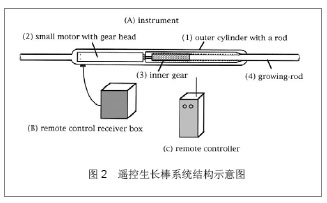
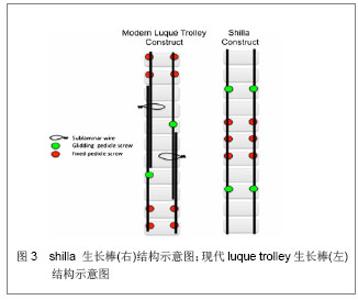
2012年香港玛丽医院的Cheung教授等[21]进行了在人体使用该技术的一项回顾性研究,在随访24个月的2例患者中,植入前的平均脊柱侧凸的Cobb角为67°,植入后24个月时为29°。每次延长生长棒后,脊柱段平均增加长度为1.9 mm。对于第1例患者,预测的与实际的生长棒延伸平均长度分别为2.3 mm和1.4 mm;对于第2例患者,植入的是双棒,左右预测的与实际的生长棒延伸平均长度分别为2.0 mm vs. 2.1 mm 和1.9 mm vs. 1.7 mm。在整个随访过程中,2例患者均无疼痛,功能预后良好,且对该手术治疗满意,未发现MCGR相关的并发症。该研究结果表明,MCGR系统可安全而有效地用于脊柱侧凸的治疗,并能最大限度地减少再次手术率,降低患者的心理困扰以及改善生活质量,且比传统的生长棒手术具有更高的成本效益。同时,该技术也可用于其他生长发育畸形的无创矫正。 2.2 生长导向技术 Luque非融合手术技术:针对Harringtong技术需要不断的延长手术,1977年Luque与Cardoso对其改进,使用椎板下钢丝连接Harringtong棒,通过钢丝在矫形棒上的滑动实现脊柱的自动生长,随后用平滑的L型棒替代Harringtong棒,形成Luque技术。其矫形原理是椎板下钢丝对每个椎体的牵拉平移,矫形力量分散到每个椎体,效果较Harringtong技术有一定的提高。Luque技术对脊柱生长的保留是靠脊柱的生长、钢丝在矫形棒的滑移来实现,不需要系列的延长手术,减少了手术次数,减小感染的风险,但椎板下钢丝有损伤脊髓的风险,如果钢丝断裂风险将更大,使终期融合手术风险增大。另外广泛的椎板下剥离导致严重的自发融合。并且Luque技术的钢丝滑移并不确切,脊柱的生长不能达到预期的程度[12,22]。 “望远镜”系统:针对Luque技术较差的滑移能力,有学者设计了一种新的节段内固定系统[23]。其矫形棒由一个实心的直径4.4 mm的细棒和一个稍粗的空心棒套插构成,两棒可以相互滑移。与脊柱的连接使用椎板下钢丝或者棘突基底钢丝,钢丝通过一聚乙烯套环垫衬后捆绑于矫形棒,聚乙烯套环减小钢丝与棒之间的摩擦,利于滑移延伸并可以较少磨屑,随脊柱的生长,生长棒自动抽出实现脊柱的自动生长。相比于Luque技术,由于套筒机构的使用,不必使用超长棒,消除末端对软组织的影响。 板棍系统:2004年叶启彬等[24]描述了脊柱侧凸矫正装置板棍系统(Plate-Rod System for scoliosis,PRSS),主要由板棍的推力提供矫形力量,上端固定,下端预留一定的生长长度,下位椎体连接器与棒不锁死,可以相互滑动。PRSS 设计主要用于治疗小儿脊柱侧弯。有4个主要部件:板棍、圆棍、钉钩及横位连接体,均由T钛合金制成。钉钩钉固在椎板上,从而可以减少脱钩危险。上下端椎板上的钉钩均用横位连接体连接。板棍和圆棍安放在上下横位连接体的圆孔或槽口内,形成坚强的矩形矫正框架,并能将矫正力分散在多个固定点上。矫正力主要由板棍于凸侧推压提供。在矫正过程中无撑开力,因此无过度矫正致截瘫的危险,板棍与圆棍的下端均伸出下端椎上横位连接体的圆孔下一段距离,并且不予固定,使其在手术后能随小儿脊柱长高而纵向延伸。而板棍及棍的上端则皆紧固在上端椎横位连接体上。本装置各部件均经过香港大学和叶启彬所在医院联合应用材料测试机MTS测试证实。用PRSS后,在压应力增力侧的椎体终板软骨退变加速,从而抑制该侧生长,而张力侧则不受影响,两侧不平衡生长达到脊柱变直的目的。用PRSS 矫治34例逐渐加重的生长中儿童特发性脊柱侧弯,侧弯术前平均63.6°,术后平均23.91°,平均矫正率64.06%,最好者为87.27%。随诊28例,平均随诊29.6个月,有15例平均矫正丢失8°,其余病例无丢失。手术矫正部位脊柱继续生长,平均13.5 mm,无严重并发症。放置PRSS后,在脊柱侧弯凸侧产生压应力,在凹侧产生张应力,而不需要植骨。PRSS矫正装置能随脊柱生长自动延伸,在治疗脊柱侧弯时不需植骨融合,通过一次手术即能满意矫正生长中儿童的脊柱侧弯,并在生长过程中维持其矫正,具有特殊的生物力学矫正能力,PRSS是治疗脊柱侧弯特别是生长中儿童脊柱侧弯的有效方法。 Shilla生长棒系统: Shilla系统是一种生长导向系统,不需要反复的手术延长[25],见图3。Shilla系统由不锈钢制成,包括矫形棒、单向和万向的椎弓根钉。系统允许脊柱沿棒的两端生长。在顶点局部4个椎体水平的融合下直接纠正畸形的顶点部分,允许其他节段的生长。Shilla技术是基于脊柱的生长,生长的保证是基于:①万向椎弓根钉在影像学的引导下植入,避免骨膜下的剥离,减少自发融合影响脊柱的生长设计。②椎弓根钉的锁定帽与椎弓根钉锁紧,而不是生长棒,约束生长棒但允许滑动。系统的效果是基于脊柱在头端和尾端的持续生长。生长的保证是骨膜外的置钉和棒与钉的滑动连接。骨膜外置钉是筋膜下层在影像学的引导下将万向椎弓根钉置入椎弓根。矢状位预弯棒以便椎弓根钉更容易捕捉棒。McCarthy在11只2月龄的骨质未成熟的山羊植入双shilla生长棒系统,术后6个处死动物。研究定期的X射线平片、CT、断层扫描、体格检查、组织学检查和微观的磨损分析。所有山羊的脊柱都生长,内植物没有移位,生长出现在生长棒的胸部和腰部末端,平均的生长长度为 48 mm。尽管在棒钉的界面观察到微小的磨损但是没有内植物的断裂。在这个山羊的模型中shilla生长导向系统可以持续的延长。但是其临床试验结果不佳,已经被NIH终止试验,其原因可能是矫形棒要连续穿过多个椎弓根钉,并在其中滑动,如果置钉稍有偏差则产生很大的摩擦力,导致无法滑动,且其抗旋转能力很弱。"
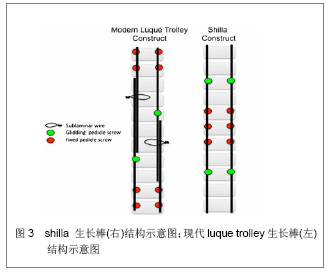

现代的Luque´Trolley自动生长棒技术:治疗早发性脊柱侧凸的挑战是既能预防侧凸的进展又能保证脊柱的生长。现在的外科治疗方法(生长棒和VEPTR)需要不断的延长手术。为了消除重复的延长手术,Ouellet[26]改进最初的luque技术,见图3,使用有限的暴露更新的植入物希望能规避传统luque技术的弊端。手术的适应证:①大的脊柱畸形(Cobb >40°-50°)。②非手术治疗失败(侧凸在6个月内进展大于10°)。③值得考虑的生长潜力(侧凸在6个月内进展大于10°)。固定锚定(椎弓根钉或者钩子连接于棒)和滑动锚定被用不同的剥离方式固定。在固定锚定点位于头端或者尾端,临近锚定点行骨膜下的剥离,因为这一节段是要被融合的。在畸形的顶端,行滑动锚定同时纠正畸形,该部位的切开尽量少的使用骨膜下剥离,使用肌间隙技术,避免自发的融合。在腰椎植入滑动椎弓根钉,避开小关节尽量减少骨的暴露。在胸椎滑动椎弓根钉插入棘突的侧方,暴露横突避免暴露椎板。影像确定椎弓根钉进入正确的位置。两对直径5 mm的钛棒从头端或尾端的切口穿过筋膜下或者肌肉间(位于筋膜以下骨膜以上)连接各椎弓根钉,用 6 mm的顶帽固定,保证棒的滑动。在可动末端使用椎板下钢丝捆扎固定,保证钛棒平行接触。随着脊柱的生长,近端固定的棒远离尾端固定的钛棒移动,滑动锚定点应该尽可能的减少自发融合的发生,但是对纠正顶点的畸形,充足的滑动锚定点是必须的。在两固定锚点之间应该平均有10个椎体。回顾2003至2008年使用现代Luque’trolley技术治疗的5例患儿。结果主弯60°矫正为 21°,并且在最短2年的随访期内维持在21°。在4年内平均10个被固定的椎体平均生长3 cm,相当于预期生长长度的77%。5例患者中有2例生长超出了棒的长度,需要更换生长棒。现代的Luque’trolley技术成功的治疗早发性脊柱侧凸,不需要反复的延长手术。 滑动环式椎弓根钉脊柱侧凸矫形系统:2007年周劲松[27]描述了滑动环式椎弓根钉脊柱侧凸矫形系统,系统由滑动环式椎弓根钉、锁定椎弓根钉及矫形棒组成。考虑患儿脊柱形态较小,滑动环式椎弓根钉直径最小设计为4 mm,末端钉尾内加工有一凹槽,与滑动环外径一致,滑动环的内径为6 mm,滑动环安装于此处,凹槽能有效限制滑动环上下移动,防其脱出,但滑动环在其中可以小量旋转,增大棒环的匹配性。盖帽拧入钉尾内对滑动环起固定作用,限制其脱出,其拧入深度正好与滑动环相接触,对滑动环无压迫作用,避免变形,增加棒环摩擦影响滑动。滑动环式椎弓根钉是该系统的功能性组件,与矫形棒构成滑动连接,连接矫形棒与脊柱,通过滑动保证脊柱的生长性能。锁定椎弓根钉直径最小4 mm,钉尾切迹较低,避免对皮下软组织的刺激及突出。锁定钉是该系统的稳定性结构,连接矫形棒与脊柱,防止矫形棒的松动和滑脱。矫形棒的直径为5.5 mm,略小于滑动环的内径,保证滑动性能。矢状面对矫形棒按照脊柱生理曲度进行预弯。使用时根据侧凸的特点确定手术节段的置钉方案,手术时使用椎旁肌入路,不进行骨膜下剥离,矫形棒置于皮下或者椎旁肌内,对侧凸范围进行节段固定,锁定钉“基座”置于侧凸下端,其余椎体植入滑动环式椎弓根钉,上方矫形棒适度留长为脊柱生长留下余地。或者锁定钉“基座”置于侧凸畸形最为严重顶椎区域,对该部分同时行矫形固定并小范围局部融合,上下方使用滑动环式椎弓根钉。置钉后根据螺钉布局安装矫形棒,使用平移或者悬臂梁脊柱进行矫形,套入滑动环锁紧固定。在该系统的动物试验中,使用该系统的山羊可以得到正常山羊一样的脊柱生长长度,同时成功制造出脊柱侧凸,说明该系统能通过对脊柱施加一定的应力,可以在保留脊柱生长的同时调控脊柱的生长,产生(纠正)脊柱侧凸畸形,但其无法控制脊柱旋转,无法避免曲轴现象。 2.3 生长调节技术 椎体骑缝钉及Tether技术: 1951年Nachlas和Borden[28]最早使用金属骑缝钉在幼犬的单侧腰椎上置入,固定相邻的椎体及椎间隙,发现幼犬出现继发性脊柱侧凸和椎体旋转的现象。在手术摘除骑缝钉以及对侧置入骑缝钉后幼犬的脊柱发育不对称得到了很好的纠正。椎体骑缝钉技术的原理是Hueter-Volkmann原理[29],随着脊柱的纵向生长逐步实现脊柱生长平衡。1954年Smith等[30]使用骑缝钉技术治疗小儿先天性脊柱侧凸,但效果并不理想,认为原因主要是两方面:①手术适应证选择不当,手术患儿侧凸度数过大,旋转较重,生长潜力有限。②骑缝钉缺陷:对椎体无把持力,跨越间隙固定,由于椎间盘的活动骑缝钉脱出甚至断裂。针对这些原因人们对骑缝钉技术进行改进,使用镍钛形状记忆合金等材料增加骑缝钉把持力。镍钛形状记忆合金骑缝钉在低温时固定齿伸直便于插入,但植入后在体温下回缩为“C”型,固定更加牢固。Braunt等[31]进行镍钛形状记忆合金骑缝钉治疗羊脊柱侧凸研究,发现侧凸得到控制,脱钉率为27%,组织学观察间顶锥区域椎体椎间盘楔形变,凹侧骨质及小梁增厚,生长板变薄,凸侧相反。认为镍钛形状记忆合金骑缝钉对椎体把持力更强,其固定齿回复力有一定矫形作用,治疗脊柱侧凸确有疗效,但仍有脱钉。由于固定太过坚强造成椎间关节强直或融合。另一种针对骑缝钉椎间存在活动特点的改进是椎体栓固术,变固定为一种半限制性的栓系,顺应椎间的活动,降低内植物承受的应力,减少脱钉风险。使用线缆等材料通过锚定钉栓系于椎间,限制固定节段的纵向生长,允许一定程度的椎间活动。Newton等[32]使用螺钉、不锈钢线缆栓固小牛单节段椎体,成功出现后凸畸形,椎体也有楔形变,但不对称栓固3个月所引起的脊柱侧凸60%是源自椎间盘的楔形变,椎体楔形变趋势是否会继续,去除栓固是否会消失需要进一步的研究。 2003 年,Betz等[33]认为行椎体骑缝钉侧凸矫形技术的指征是:①侧凸畸形发生于9岁以后。②骨骼发育不良( Risser分级≤2)。禁忌证包括:①后凸畸形超过了40°。②有全麻的禁忌证。③有明显的肺部受压,无前路融合的指征。④对镍过敏者。海涌等[34]使用胸腔镜技术在脊柱的凸侧放置骑缝钉矫正脊柱侧凸,他认为椎体骑缝钉侧凸矫形技术是控制青少年先天性脊柱侧凸畸形行之有效的方法,长期的随访结果支持此技术具有一定的优势。 2011年O’Leary等[35]回顾性研究经历开放手术的骑缝钉治疗脊椎畸形的非青春期先天性脊柱侧凸患者,明确椎体骑缝钉的有效性。回顾2003年6月至2004年8月11例接受椎体骑缝钉治疗患儿的临床记录和影像学资料,11例患儿的诊断包括脊髓发育不良、幼年的先天性脊柱侧凸和婴儿型脊柱侧凸,马凡综合征、麻痹性脊柱侧凸,神经肌肉型脊柱侧凸。手术时的平均年龄(6±11)岁。所有的患者骨骼发育未成熟。术前平均侧弯68°(22°-105°),11例患者中6例为胸主弯,5例为胸腰部主弯,4例有较小的第二弯。术前X射线片的平均侧弯为45°(24°-88°),平均随访22个月(16-28个月),在随访结束时平均侧凸69°(36°- 107°)。11例患者中有5例因为侧凸的进展接受了第二次手术:3例植入生长棒,其中1例生长棒结合前路或者后路的脊柱融合,1例脊髓发育不良患者接受双边的纵向可延长钛肋假体。剩下的6例中3例最后接受第二次手术。大于一半的患者在平均前路骑缝钉术后2年接受下一次手术。尽管相信生长调整技术对脊柱畸形的纠正有一定的作用,但它对严重的脊柱畸形的作用是不确定的。侧凸的进展是否和手术时年龄较小、术前侧凸的严重程度、侧凸的性质或者这些因素的综合有关并不清楚。因此骑缝钉不适合非青春期先天性脊柱侧凸患者。将来需要对侧凸较轻患儿行进一步的研究以确定骑缝钉的最适宜的人群。 2.4 可生长三维矫形技术 为了解决以往脊柱矫形装置不能随脊柱生长而调整,或者能调整却影响矫形效果,或者需要多次延长手术给患者带来较大痛苦的问题,2010年赵胜等[36]设计了一种可纠正侧弯,防止旋转,无需手术即可随生长发育延长,且可短节段固定,无需刻意延长椎弓根钉间距,不影响局部脊柱形态的脊柱侧弯矫形系统。其包括椎弓根钉以及若干与椎弓根钉锁定的矫形棒,其特征在于矫形棒包括套筒和可插入套筒之内的插入杆,套筒内壁与插入杆同形且二者之间为间隙配合,插入杆和套筒的配合面上设有限制插入杆相对套筒转动的定位机构。相邻两个椎弓根钉之间设置一组套筒和插入杆组合。定位机构由插入杆上的定位平台和套筒内壁上对应的平台构成,或者由插入杆上的定位凸台和套筒内壁上对应的凹槽构成。或者插入杆以及套筒内壁为相配合的异形结构,如多边形或椭圆形等。系统的使用方法与现有常规矫形钉棒系统基本相同,组合合适规格的矫形棒,预弯适应脊柱畸形,然后与椎弓根钉连接,但暂不锁死,转棒矫正侧弯畸形,然后再将矫形棒与椎弓根钉锁定,椎弓根钉与矫形棒连为一体。矫形棒虽由多节组成,但是各节连接处的套筒、插入杆结构不会发生旋转活动,因此其具有旋转稳定性,并在纵向具有延长性,可随生长而延长,不受限制。并且多个套筒可提供较大的延长性,不易随生长而拔出。此矫形棒直线结构仅限于套筒处,每处套筒处长度都很小,对局部脊柱曲度影响小,与现有的生长棒系统相比,不易造成局部脊柱的平背畸形。既可保证矫正脊柱侧弯所需的侧方稳定性和防旋转功能,同时具有沿脊柱生长方向的自动延长性。一次手术完成,术后不需一系列的延长手术。椎弓根钉可按常规方法安置,避免应力过于集中造成断棒、断钉。而且在脊柱生长过程中,脊柱有一定的纵向弹性空间,可以避免脊柱的自发融合。"

| [1] Stokes IA.Three-dimensional terminology of spinal deformity. A report presented to the Scoliosis Research Society by the Scoliosis Research Society Working Group on 3-D terminology of spinal deformity.Spine (Phila Pa 1976). 1994;19(2):236-248.http://www.ncbi.nlm.nih.gov/pubmed/8153835[2] Batra S, Ahuja S. Congenital scoliosis: management and future directions. Acta Orthop Belg. 2008;74(2):147-160.http://www.ncbi.nlm.nih.gov/pubmed/18564468[3] Harrington PR.Treatment of scoliosis. Correction and internal fixation by spine instrumentation.J Bone Joint Surg Am. 1962;44-A:591-610.http://www.ncbi.nlm.nih.gov/pubmed/14036052[4] Moe JH, Kharrat K, Winter RB, et al. Harrington instrumentation without fusion plus external orthotic support for the treatment of difficult curvature problems in young children.Clin Orthop Relat Res. 1984;(185):35-45.http://www.ncbi.nlm.nih.gov/pubmed?term=Harrington%20instrumentation%20without%20fusion%20plus%20external%20orthotic%20support%20for%20the%20treatment%20of%20diffcult%20curvature%20problems%20in%20yong%20children[5] Blakemore LC, Scoles PV, Poe-Kochert C, et al. Submuscular Isola rod with or without limited apical fusion in the management of severe spinal deformities in young children: preliminary report. Spine (Phila Pa 1976). 2001;26(18):2044-2048.http://www.ncbi.nlm.nih.gov/pubmed?term=Submuscular%20Isola%20rod%20with%20or%20without%20limited%20apical%20fusion%20in%20the%20management%20of%20severe%20spinal%20deformities%20in%20young%20children[6] Zhang H, Sucato DJ, Pierce WA,et al. Novel dual-rod screw for thoracoscopic anterior instrumentation: biomechanical evaluation compared with single-rod and double-screw/double-rod anterior constructs.Spine (Phila Pa 1976). 2009;34(5):E183-188.http://www.ncbi.nlm.nih.gov/pubmed?term=Novel%20Dual-Rod%20Screw%20for%20Thoracoscopic%20Anterior%20Instrumentation%20Biomechanical%20Evaluation%20Compared[7] Akbarnia BA, Breakwell LM, Marks DS, et al. Dual growing rod technique followed for three to eleven years until final fusion: the effect of frequency of lengthening.Spine (Phila Pa 1976). 2008;33(9):984-990.http://www.ncbi.nlm.nih.gov/pubmed?term=Dual%20Growing%20Rod%20Technique%20Followed%20for%20Three%20to%20Eleven%20Years%20Until%20Final%20Fusion%20The%20Effect%20of%20Frequency%20of%20Lengthening[8] Elsebai HB, Yazici M, Thompson GH, et al. Safety and efficacy of growing rod technique for pediatric congenital spinal deformities.J Pediatr Orthop. 2011;31(1):1-5.http://www.ncbi.nlm.nih.gov/pubmed?term=Safety%20and%20Efficacy%20of%20Growing%20Rod%20Technique%20for%20Pediatric%20Congenital%20Spinal%20Deformities[9] Mardjetko SM, Hammerberg KW, Lubicky JP, et al. The Luque trolley revisited. Review of nine cases requiring revision.Spine (Phila Pa 1976). 1992;17(5):582-589.http://www.ncbi.nlm.nih.gov/pubmed?term=The%20Luque%20trolley%20revisited%3Areview%20of%20nine%20cases%20requiring%20revision[10] Tello CA.Harrington instrumentation without arthrodesis and consecutive distraction program for young children with severe spinal deformities. Experience and technical details.Orthop Clin North Am. 1994;25(2):333-351.http://www.ncbi.nlm.nih.gov/pubmed?term=Harrington%20instrumentation%20without%20arthrodesis%20and%20consecutive%20distraction%20program%20for%20young%20children%20with%20severe%20spinal%20deformities.%20Experience%20and%20technical%20details[11] Rinsky LA, Gamble JG, Bleck EE.Segmental instrumentation without fusion in children with progressive scoliosis.J Pediatr Orthop. 1985;5(6):687-690.http://www.ncbi.nlm.nih.gov/pubmed/4066943[12] Akbarnia BA, Marks DS, Boachie-Adjei O, et al. Dual growing rod technique for the treatment of progressive early-onset scoliosis: a multicenter study.Spine (Phila Pa 1976). 2005;30(17 Suppl):S46-57.http://www.ncbi.nlm.nih.gov/pubmed/16138066[13] Yang JS, Sponseller PD, Thompson GH, et al. Growing rod fractures: risk factors and opportunities for prevention.Spine (Phila Pa 1976). 2011;36(20):1639-1644.http://www.ncbi.nlm.nih.gov/pubmed?term=Growing%20Rod%20Fractures%20Risk%20Factors%20and%20Opportunities%20for%20Prevention[14] Yang JS, McElroy MJ, Akbarnia BA, et al. Growing rods for spinal deformity: characterizing consensus and variation in current use.J Pediatr Orthop. 2010;30(3):264-270.http://www.ncbi.nlm.nih.gov/pubmed?term=Growing%20Rods%20for%20Spinal%20Deformity%3A%20Characterizing%20Consensus%20and%20Variation%20in%20Current%20Use.[15] Sankar WN, Skaggs DL, Yazici M, et al. Lengthening of dual growing rods and the law of diminishing returns.Spine (Phila Pa 1976). 2011;36(10):806-809.http://www.ncbi.nlm.nih.gov/pubmed?term=Lengthening%20of%20dualgrowing%20rods%20and%20the%20law%20of%20diminishing%20returns[16] Campbell RM Jr. Operative Strategies for Thoracic Insufficiency Syndrome by Vertical Expandable Prosthetic Titanium Rib Expansion Thoracoplasty. Operative Techniques in Orthopaedic. 2005;15: 315-325.http://www.optechorthopaedics.com/article/S1048-6666(05)00052-2/abstract[17] Mehlman CT, Al-Sayyad MJ, Crawford AH. Effectiveness of spinal release and halo-femoral traction in the management of severe spinal deformity.J Pediatr Orthop. 2004;24(6):667-673.http://www.ncbi.nlm.nih.gov/pubmed/15502568[18] Yazici M, Emans J. Fusionless instrumentation systems for congenital scoliosis: expandable spinal rods and vertical expandable prosthetic titanium rib in the management of congenital spine deformities in the growing child.Spine (Phila Pa 1976). 2009;34(17):1800-1807.http://www.ncbi.nlm.nih.gov/pubmed?term=Fusionless%20Instrumentation%20Systems%20for%20Congenital%20Scoliosis%20Expandable%20Spinal%20Rods%20and%20Vertical%20Expandable%20Prosthetic%20Titanium%20Rib%20in%20the%20Management%20of%20Congenital%20Spine%20Deformities%20in%20the%20Growing%20Child[19] Takaso M, Moriya H, Kitahara H,et al. New remote-controlled growing-rod spinal instrumentation possibly applicable for scoliosis in young children. J Orthop Sci. 1998;3(6):336-340.http://www.ncbi.nlm.nih.gov/pubmed?term=New%20remote-controlled%20growing-rod%20spinal%20instrumentation%20possibly%20applicable%20for%20scoliosis%20in%20young%20children[20] Akbarnia BA, Mundis GM Jr, Salari P,et al. Innovation in growing rod technique: a study of safety and efficacy of a magnetically controlled growing rod in a porcine model.Spine (Phila Pa 1976). 2012;37(13):1109-1114.http://www.ncbi.nlm.nih.gov/pubmed?term=Innovation%20in%20Growing%20Rod%20Technique%3A%20A%20Study%20of%20Safety%20and%20Efficacy%20of%20a%20Magnetically[21] Cheung KM, Cheung JP, Samartzis D, et al. Magnetically controlled growing rods for severe spinal curvature in young children: a prospective case series. Lancet. 2012;379(9830):1967-1974.http://www.ncbi.nlm.nih.gov/pubmed?term=Magnetically%20controlled%20growing%20rods%20for%20severe%20spinal%20curvature%20in%20young%20children%3A%20a%20prospective%20case%20series[22] Pratt RK, Webb JK, Burwell RG, et al. Luque trolley and convex epiphysiodesis in the management of infantile and juvenile idiopathic scoliosis.Spine (Phila Pa 1976). 1999;24(15):1538-1547.http://www.ncbi.nlm.nih.gov/pubmed?term=Luque%C2%B4%20trolley%20and%20convex%20epiphysiodesis%20in%20the%20management%20of%20infantile%20and%20juvenile%20idiopathic%20scoliosis[23] Wilke HJ, Kluger P, Naumann T, et al. In situ rigidity of a new sliding rod for management of the growing spine in Duchenne muscular dystrophy.Spine (Phila Pa 1976). 1996;21(17):1957-1961.http://www.ncbi.nlm.nih.gov/pubmed?term=In%20Situ%20Rigidity%20of%20a%20New%20Sliding%20Rod%20for%20Management%20of%20the%20Growing%20Spine%20in%20Duchenne%20Muscular%20Dystrophy.http://pt.wkhealth.com/pt/re/lwwgateway/landingpage.htm;jsessionid=QQpYdqh2jf7cdpFHvqMFQg26n6XY2Fc7Z4QDlQhv87Nx88nV05Mh!458665271!181195629!8091!-1?issn=0362-2436&volume=21&issue=17&spage=1957[24] 叶启彬,王以朋,张嘉,等.不需植骨融合治疗生长中儿童脊柱侧弯的新装置[J].临床骨科杂志,2004,7(1):1-5.http://www.cnki.net/KCMS/detail/detail.aspx?QueryID=0&CurRec=1&recid=&filename=LCGK200401000&dbname=CJFD2004&DbCode=CJFQ&urlid=&yx=[25] McCarthy RE, Sucato D, Turner JL,et al. Shilla growing rods in a caprine animal model: a pilot study.Clin Orthop Relat Res. 2010;468(3):705-710.http://www.ncbi.nlm.nih.gov/pubmed?term=Shilla%20Growing%20Rods%20in%20a%20Caprine%20Animal%20Model%20A%20Pilot%20Study[26] Ouellet J.Surgical technique: modern Luqué trolley, a self-growing rod technique. Clin Orthop Relat Res. 2011;469(5):1356-1367.http://www.ncbi.nlm.nih.gov/pubmed?term=Surgical%20Technique%20Modern%20Luque%C2%B4%20Trolley%2C%20a%20Self-growing%20Rod%20Technique.[27] 周劲松.一种新型生长型脊柱侧凸矫形系统的研制及动物实验研究[D].北京: 中国人民解放军军医进修学院, 2007.http://www.cnki.net/KCMS/detail/detail.aspx?dbcode=CDFD&QueryID=29&CurRec=32&dbname=CDFD9908&filename=2007075355.nh&urlid=&yx=[28] Nachlasiw IW, Borden JN.The cure of experimental scoliosis by directed growth control.J Bone Joint Surg Am. 1951;33(A:1):24-34.http://www.ncbi.nlm.nih.gov/pubmed?term=The%20cure%20of%20experimental%20scoliosis%20by%20directed%20growth%20control.[29] Stokes IA, Spence H, Aronsson DD,et al. Mechanical modulation of vertebral body growth. Implications for scoliosis progression.Spine (Phila Pa 1976). 1996;21(10):1162-1167http://www.ncbi.nlm.nih.gov/pubmed?term=Mechanical%20modulation%20of%20vertebral%20body%20growth.%20Implications%20for%20scoliosis%20progression[30] Smith AD, Vonlackum WH, Wylie R. An operation for stapling vertebral bodies in congenital scoliosis. J Bone Joint Surg Am. 1954;36(A:2):342-348.http://www.ncbi.nlm.nih.gov/pubmed?term=Anoperation%20for%20stapling%20vertebral%20bodies%20in%20congenital%20scoliosis.[31] Braun JT, Ogilvie JW, Akyuz E, et al. Fusionless scoliosis correction using a shape memory alloy staple in the anterior thoracic spine of the immature goat.Spine (Phila Pa 1976). 2004;29(18):1980-1989.http://www.ncbi.nlm.nih.gov/pubmed?term=fusionless%20correction%20using%20a%20shape%20memory%20alloy%20staple%20in%20the%20anterior%20thoracic%20spine%20of%20the%20immature%20goat[32] Newton PO, Fricka KB, Lee SS, et al. Asymmetrical flexible tethering of spine growth in an immature bovine model.Spine (Phila Pa 1976). 2002;27(7):689-693.http://www.ncbi.nlm.nih.gov/pubmed?term=Asymmetrical%20flexible%20tethering%20of%20spine%20growh%20in%20an%20immature%20bovine%20model.[33] Betz RR, Kim J, D'Andrea LP,et al. An innovative technique of vertebral body stapling for the treatment of patients with adolescent idiopathic scoliosis: a feasibility, safety, and utility study.Spine (Phila Pa 1976). 2003;28(20):S255-265.http://www.ncbi.nlm.nih.gov/pubmed?term=An%20innovative%20technique%20of%20vertebral%20body%20stapling%20for%20the%20treatment%20of%20patients%20with%20adolescent%20idiopathic%20sciliosis%3A%20a%20feasibility%EF%BC%8Csafety%EF%BC%8Cand%20utility%20study[34] 海涌,吴继功,李宝俊. 非融合手术治疗脊柱侧凸的研究进展[J]. 中国脊柱脊髓杂志, 2006,16(3): 232 -234.http://www.cnki.net/KCMS/detail/detail.aspx?QueryID=8&CurRec=1&recid=&filename=ZJZS200603017&dbname=cjfd2006&DbCode=CJFQ&urlid=&yx=[35] O'leary PT, Sturm PF, Hammerberg KW,et al. Convex hemiepiphysiodesis: the limits of vertebral stapling.Spine (Phila Pa 1976). 2011;36(19):1579-1583.http://www.ncbi.nlm.nih.gov/pubmed?term=O%E2%80%99Leary%20Convex%20Hemiepiphysiodesis%20The%20Limits%20of%20Vertebral%20Stapling[36] 赵胜,卫小春,李凯. 一种自动延长并防旋转的脊柱侧弯矫形系统:中国,CN201020109096.2 [P]. 2010-01-31.http://dbpub.cnki.net/grid2008/dbpub/detail.aspx?QueryID=15&CurRec=1&dbcode=scpd&dbname=SCPD2010&filename=CN201684005U&urlid=&yx= |
| [1] | Lu Dezhi, Mei Zhao, Li Xianglei, Wang Caiping, Sun Xin, Wang Xiaowen, Wang Jinwu. Digital design and effect evaluation of three-dimensional printing scoliosis orthosis [J]. Chinese Journal of Tissue Engineering Research, 2021, 25(9): 1329-1334. |
| [2] | Liang Yan, Zhao Yongfei, Xu Shuai, Zhu Zhenqi, Wang Kaifeng, Liu Haiying, Mao Keya. Imaging evaluation of short-segment fixation and fusion for degenerative lumbar scoliosis assisted by highly selective nerve root block [J]. Chinese Journal of Tissue Engineering Research, 2021, 25(9): 1423-1427. |
| [3] | Liang Yan, Zhao Yongfei, Zhu Zhenqi, Liu Haiying, Mao Keya. Minimally invasive transforaminal lumbar interbody fusion in the treatment of sciatic scoliosis caused by lumbar disc herniation: a 2-year follow-up of coronal and sagittal balance [J]. Chinese Journal of Tissue Engineering Research, 2021, 25(3): 409-413. |
| [4] | Xue Jingbo, Zhu Bin, Li Zepeng, Wang Cheng, Ouyang Zhihua, Yan Yiguo. Biomechanical characteristics of a sleeve-type guided growth rod in a six-degree-of-freedom joint robot [J]. Chinese Journal of Tissue Engineering Research, 2021, 25(15): 2297-2302. |
| [5] | Zhou Chen, Xing Wenhua. Application advantages of three-dimensional printing technology and finite element analysis in scoliosis correction [J]. Chinese Journal of Tissue Engineering Research, 2021, 25(12): 1898-1903. |
| [6] |
Zhang Cong, Zhao Yan, Du Xiaoyu, Du Xinrui, Pang Tingjuan, Fu Yining, Zhang Hao, Zhang Buzhou, Li Xiaohe, Wang Lidong.
Biomechanical analysis of the lumbar spine and pelvis in adolescent
idiopathic scoliosis with lumbar major curve |
| [7] | Zhao Dezhu, Guan Tianmin, Wu Bin, Mei Zhao. Design and implementation of an adolescent idiopathic scoliosis orthosis design expert system based on fuzzy logic [J]. Chinese Journal of Tissue Engineering Research, 2020, 24(33): 5255-5261. |
| [8] | Li Hongke, Hao Shenshen, Wang Pengcheng, Yang Hongjie, Dong Shengli, Liu Shuai, Wang Fei, Liu Zhibin. Accuracy of 3D printing navigation template in pedicle screw placement for idiopathic scoliosis [J]. Chinese Journal of Tissue Engineering Research, 2020, 24(30): 4757-4762. |
| [9] | Sun Jian, Fang Chao, Gao Fei, Wei Laifu, Qian Jun. Clinical efficacy and complications of short versus long segments of internal fixation for the treatment of degenerative scoliosis: a meta-analysis [J]. Chinese Journal of Tissue Engineering Research, 2020, 24(3): 438-445. |
| [10] | Wen Wangqiang, Xu Haoxiang, Zhang Zepei, Miao Jun. Related factors and biomechanical characteristics of lumbar facet joint degeneration [J]. Chinese Journal of Tissue Engineering Research, 2020, 24(24): 3883-3889. |
| [11] |
Wang Mengran, Fu Zhiyi, Wang Huidong, Wu Yujie.
Efficacy and complications of different viscosities of high-dose
bone cement applied in percutaneous vertebroplasty |
| [12] | Gao Jian’an, Chen Xi, Zhang Longsheng, Liao Wenbo. Types and advantages of spinal implants in percutaneous kyphoplasty [J]. Chinese Journal of Tissue Engineering Research, 2020, 24(12): 1935-1940. |
| [13] | Zhang Yufang, Guan Tianmin, Guo Qiaoge, Zhang Yufen, Guo Yanli. Digital design of personalized scoliosis orthopedic braces based on 3D printing technology [J]. Chinese Journal of Tissue Engineering Research, 2019, 23(36): 5824-5829. |
| [14] | He Da, Zhao Jingwei, Liu Bo, Tian Wei. Comparison of limited fusion and full curve fusion for mild lumbar degenerative scoliosis with stenosis [J]. Chinese Journal of Tissue Engineering Research, 2019, 23(36): 5811-5817. |
| [15] | Sun Fengyuan, Li Zongyuan, He Xi, Yang Zongde. Application and progress of finite element analysis in scoliosis biomechanical research [J]. Chinese Journal of Tissue Engineering Research, 2019, 23(32): 5221-5226. |
| Viewed | ||||||
|
Full text |
|
|||||
|
Abstract |
|
|||||
